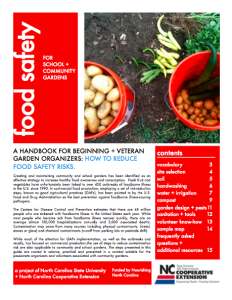My grandparents introduced me to vegetable gardening when I was a kid. I used to leave the city for a couple of weeks each summer and visit them in Campbellford, Ontario (that’s in Canada) and they’d put me to work in their garden. I’d pull weeds, pick up fallen tomatoes (for the compost) and help pick green beans. It’s all a bit hazy, but looking back they didn’t let me handle anything that was ready to eat. Probably because I was dirty.
A few years ago my group was asked by the great folks at the NC Department of Public Instruction about the safety of produce in school gardens. As concerns over healthy food choices grew, more schools were asking about growing their own produce and using gardens as a teaching tool as well as a source of food. The food safety team correctly worried about risks.
I couldn’t find much in the literature on the about pathogens or even production practices at gardens so I figured a good place to start was to get into the field and figure out what was going on. Ashley Chaifetz, barfblog contributor and PhD student at UNC Chapel Hill worked for a summer to figure out the situation and came up with a short document to get garden organizers started (see growingsafergardens.com for all the materials). As a follow-up, Ashley also conducted an evaluation of the materials with the audience and presented the results at IAFP in 2013.
School and community gardens have a challenge around volunteers and not-so-clean kid hands (like mine when I was eight), but managing risks is doable if someone in charge is paying attention.
According to the Australian Institute of Food Safety, Ausveg, an Australian produce industry group has concerns about community garden organizers ability to manage pests as well as food safer.
They’re meant to bring neighbourhoods together and encourage an interest in gardening, but Ausveg says that community gardens also pose a serious safety risk for the nation’s horticulture sector.
Lack of Quality Assurance Guidelines Posing Risk of Infestations
“A lot of these gardens may not be in the best nick, so to speak, and the issue we then have is with infestations with either pests or diseases, and then that becomes a threat in itself to commercial horticultural operations that need to comply with strict adherence to quality assurance guidelines,” explained Ausveg spokesperson William Churchill.
He added that if community gardens bring in pests and diseases, commercial growers must take pre-emptive action to stop these problems affecting their crops.
Mr Churchill also took aim at farmers’ markets, commenting that Ausveg also has concerns “about food standards and quality assurance programs that are in place.”
They could start by checking out our document.
